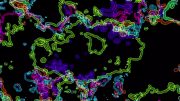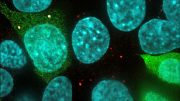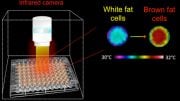
Microproteins and small proteins called smORFs are potentially a rich source of uncharacterized regulators of metabolism. Credit: Salk Institute and Cell Metabolism
Scientists uncovered over 3,800 tiny proteins that play a role in metabolism and discovered that one microprotein, Gm8773, boosts feeding activity in mice – offering a potential solution to help people with diseases like cancer gain weight.
In the US, obesity and diabetes are widespread diseases. Microproteins, small proteins, have been previously overlooked in research but recent studies suggest they play a crucial role in metabolism. Researchers at the Salk Institute have found that both white and brown fat contain numerous unknown microproteins and one of these microproteins, Gm8773, has the ability to increase appetite in mice.
The findings, recently published in the journal Cell Metabolism, could result in a therapeutic to increase weight in specific diseases such as during cancer chemotherapy. The team’s discovery of these microproteins also provides valuable resources for the scientific community to further study microproteins.

From left: Alan Saghatelian and Thomas Martinez. Credit: Salk Institute and Steve Zylius from UC Irvine
“It is vital to better understand the processes that regulate obesity and metabolic health in order to provide improved therapies for the future,” says Salk Professor Alan Saghatelian, co-corresponding author of the study and holder of the Dr. Frederik Paulsen Chair. “Having this list of microproteins will aid the field of metabolism in identifying new players in a variety of metabolic diseases. And we’ve demonstrated one biologically active microprotein that promotes feeding, as well as other microproteins that are involved in fat metabolism.”
Fat tissue secretes many different proteins to regulate feeding, energy balance, and the production of heat. White fat, known as “bad fat,” is often found just beneath the skin and in the abdominal region. This type of fat acts as an energy storage depot and is related to obesity and other diseases caused by excess weight. In contrast, brown fat or “good fat” is located around the shoulders and along the spinal cord. Brown fat is associated with proper nutrition, exercise, and health.
In this study, the scientists used innovative genomics technologies to examine the brown, white, and beige fat (another type of fat with features similar to both white and brown fat) in mouse cells. They discovered 3,877 genes that produce microproteins in both white and brown fat. Additionally, they explored the levels of these genes in mice fed a high-fat Western diet, and linked hundreds of microproteins to changes in fat tissue metabolism. Overall, the analysis highlights many likely metabolically relevant microproteins for the first time.
“We’ve provided a roadmap on how to best use our data to link and eventually characterize the roles of microproteins in fundamental metabolic pathways,” says first author Thomas Martinez, a former postdoctoral fellow in Saghatelian’s lab who is now an assistant professor at UC Irvine.
The team also focused in on a microprotein called Gm8773, located in the feeding center of the brain, called the hypothalamus. The location of the microprotein in the brain suggested it may play a role in appetite. Indeed, when the scientists administered Gm8773 to obese mice, the mice consumed more food. There is also a human gene similar to Gm8773 called FAM237B, and this gene could act similarly in humans to promote eating. According to the researchers, this microprotein could eventually be developed into a therapeutic to promote weight gain in those experiencing extreme weight loss.
“The new microproteins presented in our study are exciting discoveries for the field of metabolism and for the study of fat biology,” says co-corresponding author Chris Barnes, formerly of Novo Nordisk Research Center Seattle, Inc., now head of proteomics at Velia Therapeutics. “We hope that this resource will be used to generate numerous new experimental hypotheses for the scientific community to test in their own labs and that this work leads to the identification of novel mechanisms in biology.”
In the future, the scientists plan to develop tools to investigate the roles of Gm8773 and FAM237B with the goal of eventually developing a therapeutic that can increase appetite in humans.
Reference: “Profiling mouse brown and white adipocytes to identify metabolically relevant small ORFs and functional microproteins” by Thomas F. Martinez, Sally Lyons-Abbott, Angie L. Bookout, Eduardo V. De Souza, Cynthia Donaldson, Joan M. Vaughan, Calvin Lau, Ariel Abramov, Arian F. Baquero, Karalee Baquero, Dave Friedrich, Justin Huard, Ray Davis, Bong Kim, Ty Koch, Aaron J. Mercer, Ayesha Misquith, Sara A. Murray, Sakara Perry, Lindsay K. Pino and Christopher A. Barnes, 3 January 2023, Cell Metabolism.
DOI: 10.1016/j.cmet.2022.12.004
The study was funded by the National Institutes of Health, Frederick Paulsen and the Ferring Foundation, a sponsored research agreement with Novo Nordisk Research Center Seattle, Inc., the National Institute of Science and Technology on Tuberculosis, Brazil, the National Council for Scientific and Technological Development of Brazil, and the Coordenação de Aperfeiçoamento de Pessoal de Nível Superior—Brasil.









Be the first to comment on "Scientists Have Discovered a Microprotein That Increases Appetite"